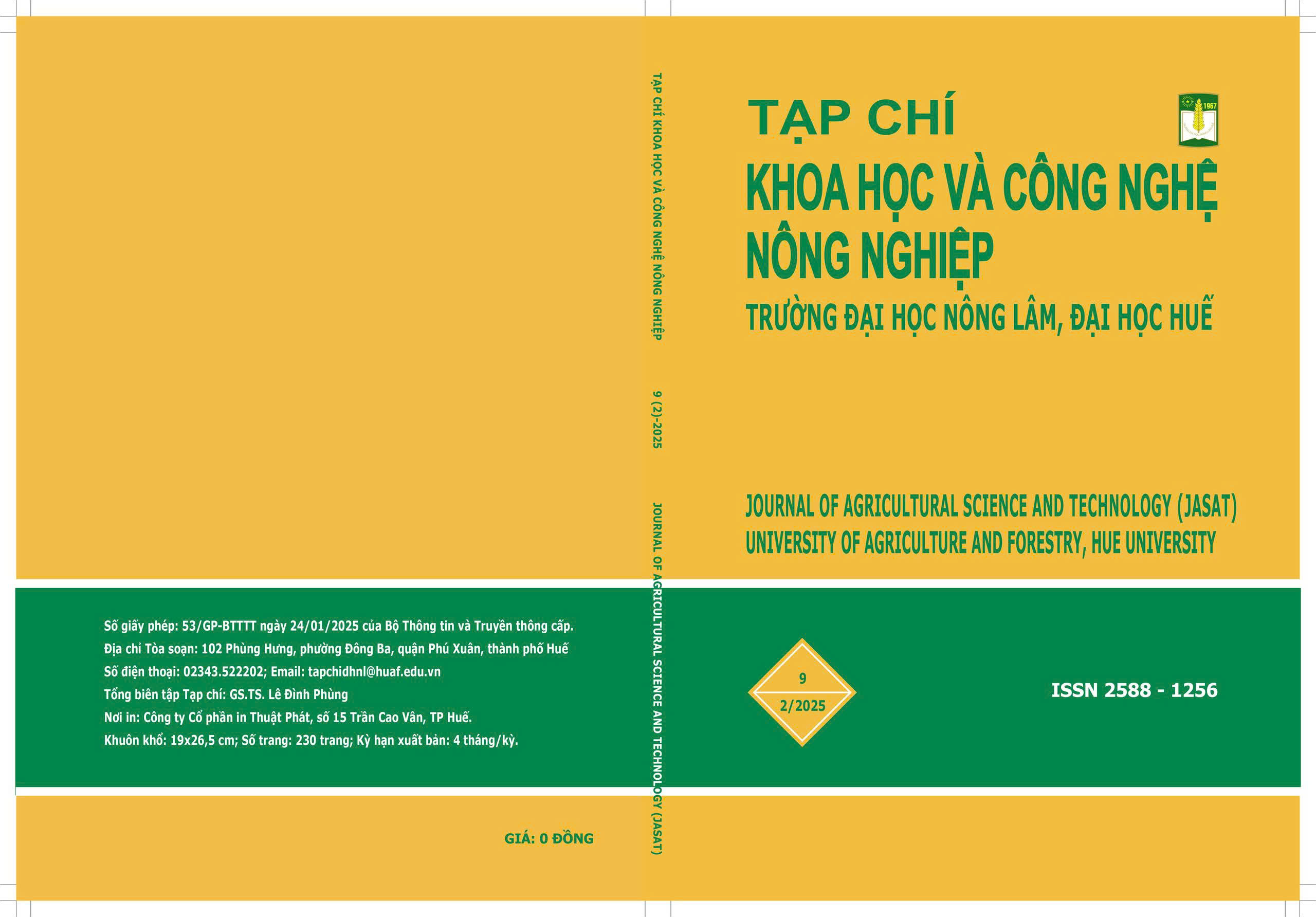##plugins.themes.huaf_theme.article.main##
Tóm tắt
É lớn tròng (Hyptis suaveolens (L.) Poit.) là dược liệu tiềm năng, song chưa có nghiên cứu về hoạt tính gây độc tế bào tại Việt Nam, đặc biệt ở thành phố Huế. Nghiên cứu nhằm phân tích đặc điểm hình thái, vi học, thành phần hóa học và hoạt tính gây độc tế bào của tinh dầu từ phần trên mặt đất của loài H. suaveolens thu hái tại phường Hương Long, quận Phú Xuân, thành phố Huế. Đặc điểm hình thái, vi học được phân tích bằng phương pháp nhuộm kép kết hợp với kính hiển vi; chiết xuất tinh dầu bằng phương pháp lôi cuốn hơi nước, xác định thành phần hóa học bằng GC-MS và đánh giá độc tính trên các dòng tế bào HepG2, A549, MCF7. Đặc điểm thực vật của é lớn tròng ở Huế tương đồng với các khu vực khác. Định danh được 33 hợp chất chiếm 80,26% tinh dầu, chủ yếu là sesquiterpen (30,98%) và monoterpen (30,91%) chiếm ưu thế, thành phần chính là (E)-caryophyllene (18,34%) và 1,8-cineole (18,08%). Tinh dầu có hoạt tính gây độc tế bào ung thư với IC50 lần lượt là 10,94, 11,77 và 9,50 µg/mL. Nghiên cứu đã cung cấp dữ liệu về đặc điểm thực vật, thành phần hóa học và hoạt tính gây độc tế bào của tinh dầu loài H. suaveolens tại Việt Nam.
##plugins.themes.huaf_theme.article.details##
Tài liệu tham khảo
Bộ Y Tế. (2017). Dược điển Việt Nam V: Nhà Xuất Bản Y học
Võ Văn Lẹo và Trần Ngọc Tín. (2022). Đặc điểm thực vật học cây tía tô dại (Hyptis suaveolens L. (Poit.), họ bạc hà (Lamiaceae). Tạp chí Y học Thành phố Hồ Chí Minh, 26(02), 10-18.
Vũ Thị Thu Lê, Trần Huy Thái, Nguyễn Thị Hiền, Trịnh Xuân Thành, Đinh Thị Thu Thủy và Trần Thị Tuyến. (2023). Thành phần hoá học của tnh dầu phần trên mặt đất é lớn tròng (Hyptis suaveolens (L.) Poit. và é hình thoi (Hyptis rhomboidea Mart Et Gal.) ở Việt Nam. TNU Journal of Science and Technology, 228(13), 351-357. DOI:10.34238/tnu-jst.7666
Vũ Xuân Phương. ( 2000). Thực vật chí Việt Nam - Flora of Vietnam (Vol. 2). Hà Nội: Nhà Xuất Bản Khoa học và Kỹ thuật.
Nguyễn Viết Thân. (2003). Kiểm nghiệm dược liệu bằng phương pháp hiển vi: Nhà xuất bản Khoa học và Kĩ thuật.
Nguyễn Nghĩa Thìn. (2007). Các phương pháp nghiên cứu thực vật: Nhà xuất bản Đại học Quốc gia Hà Nội.
Adams, R. P. (2017). Identification of essential oil components by gas chromatography/mass spectrometry. Carol Stream, Illinois: Allured Publishing.
Fahn, A. (1990). Plant Anatomy: Pergamon Press.
Imade, R., Ayinde, B., Choudhary, M. & Alam, A. (2021). Chemical composition and anticancer effects of Hyptis suaveolens L. Poit. (Lamiaceae) volatile oil. Nigerian Journal of Natural Products and Medicine, 25(1), 64-69. DOI:10.4314/njnpm.v25i1.6
Joy, B., Omanakutty, M. & Mathew, M. (2008). Antibacterial effects and chemical composition of the essential oil of Hyptis suaveolens Poit leaves. Journal of Essential Oil Bearing Plants, 11(4), 384-390. DOI:10.1080/0972060X.2008.10643644
Joy, B., Omanakutty, M. & Mathew, M. (2008). Chemical composition of the essential oil of Hyptis suaveolens Poit leaves from Senegal. World Journal of Organic Chemistry, 10(1), 1-3.
Juergens, U. (2014). Anti-inflammatory properties of the monoterpene 1.8-cineole: current evidence for co-medication in inflammatory airway diseases. Drug research, 64(12), 638-646. DOI:10.1055/s-0034-1372609
Legault, J. & Pichette, A. (2007). Potentiating effect of β‐caryophyllene on anticancer activity of α‐humulene, isocaryophyllene and paclitaxel. Journal of Pharmacy and Pharmacology, 59(12), 1643-1647. doi:https://doi.org/10.1211/jpp.59.12.0005
Malele, R., Mutayabarwa, C., Mwangi, J., Thoithi, G., Lopez, A., Lucini, E. I. & Zygadlo, J. A. (2003). Essential oil of Hyptis suaveolens (L.) Poit. from Tanzania: Composition and antifungal activity. Journal of Essential Oil Research, 15(6), 438-440. DOI:10.1080/10412905.2003.9698633
Monks, A., Scudiero, D., Skehan, P., Shoemaker, R., Paull, K., Vistica, D., Hose, C., Langley, J., Cronise, P., Vaigro-Wolff, A., Gray-Goodrich, M., Campbell, H., Mayo, J. & Boyd, M. (1991). Feasibility of a high-flux anticancer drug screen using a diverse panel of cultured human tumor cell lines. Journal of the National Cancer Institute, 83(11), 757-766. DOI:10.1093/jnci/83.11.757
Moreira, A. C. P., Carmo, E. S., Wanderley, P. A., da Souza, E. L., & da Oliveira Lima, E. (2013). Inhibitory effect of the essential oil from Hyptis suaveolens (L.) Poit on the growth and aflatoxins synthesis of Aspergillus flavus. Journal of Life Sciences, 7(3), 276-281.
Murata, S., Shiragami, R., Kosugi, C., Tezuka, T., Yamazaki, M., Hirano, A., Yoshimura, Y., Suzuki, M., Shuto, K., & Ohkohchi, N. (2013). Antitumor effect of 1, 8-cineole against colon cancer. Oncology reports, 30(6), 2647-2652. doi:https://doi.org/10.3892/or.2013.2763
Oscar, S.-A., Antonio, C.-N., Marina, G.-V., Elsa, R.-S., & Gabriel, V.-A. (2020). Phytochemical screening, antioxidant activity and in vitro biological evaluation of leave extracts of Hyptis suaveolens (L.) from south of Mexico. South African Journal of Botany, 128, 62-66. DOI:10.1016/j.sajb.2019.10.016
Panwar, D. (2024). Exploring the phytochemical and pharmacological properties of Hyptis suaveolens L. in experimental models. American Journal Of Biomedical Science & Pharmaceutical Innovation, 4(11), 8-14.
Poonkodi, K., Karthika, J., Tamilselvi, V., Anitha, R., & Vasanthamani, S. (2017). Chemical composition of essential oil of Hyptis suaveolens (L.) Poit. and its invitro anticancer activity. Journal of Pharmacy Research, 11(5), 410-413.
Tachakittirungrod, S., & Chowwanapoonpohn, S. (2007). Comparison of antioxidant and antimicrobial activities of essential oils from Hyptis suaveolens and Alpinia galanga growing in Northern Thailand. Chiang Mai University Journal of Natural Sciences, 6(1), 31-41.
Umberto Quattrocchi. (2014). CRC world dictionary of medicinal and poisonous plants: common names, scientific names, eponyms, synonyms, and etymology Boca Raton, Florida, USA: CRC Press.
Wu, Z., Raven, P. H., & Garden, M. B. (1994). Flora of China (Vol. 17). Beijing: Science Press.
Xu, D.-H., Huang, Y.-S., Jiang, D.-Q., & Yuan, K. (2013). The essential oils chemical compositions and antimicrobial, antioxidant activities and toxicity of three Hyptis species. Pharmaceutical Biology, 51(9), 1125-1130. DOI:10.3109/13880209.2013.781195


